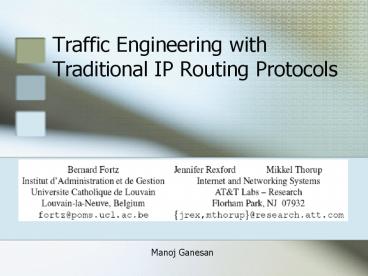Traffic Engineering with Traditional IP Routing Protocols - PowerPoint PPT Presentation
1 / 15
Title:
Traffic Engineering with Traditional IP Routing Protocols
Description:
Traffic Engineering with Traditional IP Routing Protocols. Manoj Ganesan. Aim of the Paper ... Use link weights to express routing config: Compatibility with ... – PowerPoint PPT presentation
Number of Views:143
Avg rating:3.0/5.0
Title: Traffic Engineering with Traditional IP Routing Protocols
1
Traffic Engineering with Traditional IP Routing
Protocols
Manoj Ganesan
2
Aim of the Paper
- Provides an overview of working with the
traditional IP routing protocols. - No modification to the routing protocols or the
routers themselves. - How to adapt link weights, based on a
network-wide view of the traffic and topology
within a domain. - Summarizing the results of techniques for
optimizing OSPF/IS-IS weights to the prevailing
traffic.
3
Introduction
- In some sense, IP networks manage themselves.
- Adjusting sending rate depending on bandwidth
- Routers compute new paths
- However these mechanisms do ensure efficiency.
- Eg Under-utilized links.
- The focus of this paper would be traffic within a
single AS (company, ISP, etc).
4
Intradomain Traffic Engineering
- Path selection based on Static Link Weights.
- Limitations of static link weights, at the outset
- Limited routing scenarios.
- No adaption of link weights, basically.
- Expensive extensions have been proposed.
- Can modify static link weights to do the job
5
A simple example.
- Initial configuration 3 units of load on (u,t)
- Local change to the weight of the congested link,
increased to 2. 2.5 units of load on (w,t). - Global optimization of the link weights. Most
optimal solution.
6
Advantages of using traditional OSPF
- Process of arriving at a good set of weights is
handled externally from the routers. - Modification of link weights is performed on a
relatively coarse time scale. - Centralized approach for setting routing
parameters. Has the following advantages - Protocol stability.
- Low protocol overhead.
- Use link weights to express routing config
- Compatibility with traditional shortest path
IGPs. - Concise representation.
7
Traffic Engineering Framework.
- Measure
- Should have a timely and accurate view of the
current state of the network. - Estimate of the volume of traffic between each
pair of routers. - Model
- Control
- Appropriate commands to affected routers.
- Router updates its link-state database floods
the new value of the rest of the network. - Each router computes new shortest paths.
- No frequent changes to link weights.
8
Performance properties
- Quantifying how well we can engineer traffic flow
using traditional OSPF/IS-IS routing protocols. - Link Utilization.
- Comparing solutions with OPT routing, and simple
configurations like InvCapOSPF and UnitOSPF. - Returning back to our original example.
- UnitOSPF and InvCapOSPF, utilization 150
(u,v). - Last diagram, utilization for u,v 100.
9
Performance comparison with a network wide
objective
- Advanced OSPF, comes closest to OPT routing (only
3 worse utilization than OPT) - Minimizing max link utilization might be too
specific and localized. - Unavoidable congested links.
- No penalty to solutions that force traffic to
traverse very long paths. - Advances OSPF has an additional objective.
- The cost of using a link increases with the
utilization, with an explosive growth as the
utilization exceeds 100 - Network wide cost of a routing solution is then
the sum of all link costs.
10
Link cost as a function of the load for a link
capacity 1
11
Network-wide cost vs. demand for a proposed ATT
backbone
12
Max link utilization vs. demand with same weights
as previous graph
13
Changing traffic demands
- Optimizing the weights for a single topology and
traffic matrix is not sufficient. - Robustness was tested by changing traffic
matrices, fluctuations, errors, etc. - Previous weight settings (for the original TM)
continued to perform well. - Optimizing weights across traffic matrices!
14
Few changes to Link Weights
- Changes to link weights are necessary in response
to large shifts in traffic and certain router or
link failures. - Fortunately, changing even a single link weight
is often effective. - For an operational ATT topology, increasing a
single weight from 1024 to 1025 could reduce max
utilization by 8. - Also, existing IGP weights continued to do well
even after a single link failure.
15
Conclusions
- An overview of how to modify existing IP
protocols to work efficiently in case of traffic
fluctuations. - This approach treats traffic engineering as a
networks operation task, rather than a
responsibility of the underlying routing
protocol. - As mentioned before, modifying traditional
protocols have many advantages over proposed
traffic engineering extensions to these protocols.































